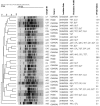Antimicrobial resistance and genetic diversity of Escherichia coli isolated from humans and foods
- PMID: 26691477
- PMCID: PMC4704651
- DOI: 10.1590/S1517-838246420130874
Antimicrobial resistance and genetic diversity of Escherichia coli isolated from humans and foods
Abstract
Antibiotic resistance has increased in recent years, raising the concern of public health authorities. We conducted a study of Escherichia coli isolates obtained from human and food samples to assess the prevalence of antimicrobial resistance and to determine the genotype and clonal relationship of 84 E. coli isolates (48 from humans and 36 from foods). An antimicrobial susceptibility test was performed using the disk diffusion method. Virulence factors were evaluated by multiplex PCR, and the clonal relationship among the resistant isolates was studied by Pulsed Field Gel Electrophoresis (PFGE). All isolates were susceptible to ceftriaxone. Overall, 26%, 20.2%, 15.4% and 6% of the isolates were resistant to tetracycline, ampicillin, sulfamethoxazole/trimethoprim and cephalotin, respectively. Twenty two percent of the isolates exhibited resistance to more than one antimicrobial agent. Multiple-drug resistance was mostly observed in the human isolates and involved the antibiotics ampicillin and tetracycline. None of the six virulence genes were identified among the isolates. Analysis of genetic diversity by PFGE of 31 resistant isolates, revealed 29 distinct restriction patterns. In conclusion, E. coli from humans and foods are resistant to commonly used antibiotics and are highly genetically diverse. In this setting, inappropriate use of antibiotics may be a cause of high resistance rate instead of clonal spread.
Figures

Similar articles
-
Characteristics of Romanian fluoroquinolone-resistant human clinical Escherichia coli isolates.Roum Arch Microbiol Immunol. 2008 Jan-Jun;67(1-2):23-9. Roum Arch Microbiol Immunol. 2008. PMID: 19284163
-
Extraintestinal Pathogenic and Antimicrobial-Resistant Escherichia coli Contamination of 56 Public Restrooms in the Greater Minneapolis-St. Paul Metropolitan Area.Appl Environ Microbiol. 2015 Jul;81(13):4498-506. doi: 10.1128/AEM.00638-15. Epub 2015 Apr 24. Appl Environ Microbiol. 2015. PMID: 25911488 Free PMC article.
-
Detection of quinolone-resistant Escherichia coli isolates belonging to clonal groups O25b:H4-B2-ST131 and O25b:H4-D-ST69 in raw sewage and river water in Barcelona, Spain.J Antimicrob Chemother. 2013 Apr;68(4):758-65. doi: 10.1093/jac/dks477. Epub 2012 Dec 7. J Antimicrob Chemother. 2013. PMID: 23221627
-
Prevalence and genetic relatedness of antimicrobial-resistant Escherichia coli isolated from animals, foods and humans in Iceland.Zoonoses Public Health. 2010 May;57(3):189-96. doi: 10.1111/j.1863-2378.2009.01256.x. Epub 2009 Nov 13. Zoonoses Public Health. 2010. PMID: 19912612
-
National survey of Escherichia coli causing extraintestinal infections reveals the spread of drug-resistant clonal groups O25b:H4-B2-ST131, O15:H1-D-ST393 and CGA-D-ST69 with high virulence gene content in Spain.J Antimicrob Chemother. 2011 Sep;66(9):2011-21. doi: 10.1093/jac/dkr235. Epub 2011 Jun 13. J Antimicrob Chemother. 2011. PMID: 21669946
Cited by
-
Antibiotic resistance, virulence factors and genotyping of Uropathogenic Escherichia coli strains.Antimicrob Resist Infect Control. 2018 Oct 3;7:118. doi: 10.1186/s13756-018-0411-4. eCollection 2018. Antimicrob Resist Infect Control. 2018. PMID: 30305891 Free PMC article.
-
Antimicrobial resistance patterns among different Escherichia coli isolates in the Kingdom of Saudi Arabia.Saudi J Biol Sci. 2021 Jul;28(7):3776-3782. doi: 10.1016/j.sjbs.2021.03.047. Epub 2021 Mar 23. Saudi J Biol Sci. 2021. PMID: 34220231 Free PMC article.
-
Common findings of bla CTX-M-55-encoding 104-139 kbp plasmids harbored by extended-spectrum β-lactamase-producing Escherichia coli in pork meat, wholesale market workers, and patients with urinary tract infection in Vietnam.Curr Microbiol. 2017 Feb;74(2):203-211. doi: 10.1007/s00284-016-1174-x. Epub 2016 Dec 9. Curr Microbiol. 2017. PMID: 27942843
-
Effect of amoxicillin-clavulanic acid on clinical scores, intestinal microbiome, and amoxicillin-resistant Escherichia coli in dogs with uncomplicated acute diarrhea.J Vet Intern Med. 2020 May;34(3):1166-1176. doi: 10.1111/jvim.15775. Epub 2020 Apr 23. J Vet Intern Med. 2020. PMID: 32324947 Free PMC article.
References
-
- Aarestrup FM, Wegener HC. The effect of antibiotic usage in food animals on the development of antimicrobial resistance of importance for human in Campylobacter and Escherichia coli. . Microb Infect. 1999;1:639–644. - PubMed
-
- Altalhi AD, Gherbawy YA, Hassan SA. Antibiotic Resistance in Escherichia coli Isolated from Retail Raw Chicken Meat in Taif, Saudi Arabia. Foodborne Pathog Dis. 2000;7:281–285. - PubMed
-
- Angulo FJ, Nargund VN, Chiller TC. Evidence of an Association Between use of Anti-microbial Agents in Food Animals and Anti-microbial Resistance Among Bacteria Isolated from Humans and the Human Health Consequences of Such Resistance. J Vet Med Series B. 2004;51:374–379. - PubMed
-
- Bender JB, Hedberg CW, Besser JM, et al. Surveillance by molecular subtype for Escherichia coli O157:H7 infections in Minnesota by molecular subtyping. New Eng J Med. 1997;337:388–394. - PubMed
-
- Brazil Approves the Technical Regulation for manufacturing, quality control, marketing and use of antimicrobial products for veterinary use. 2009. Ministry of Agriculture, Livestock and Supply. Office of the Minister. Normative Instruction No. 26, July 9, 2009. Published in the Official Gazette of July 10, 2009, Section 1.
Publication types
MeSH terms
Substances
LinkOut - more resources
Full Text Sources
Medical
